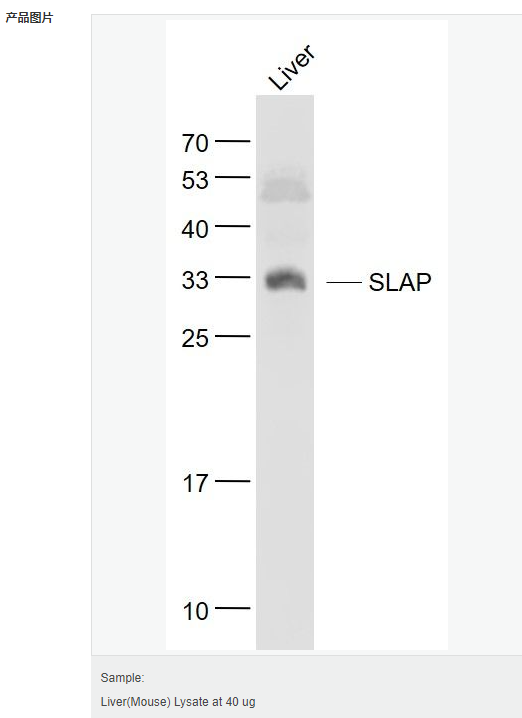

貨號
產(chǎn)品規(guī)格
售價
備注
BN40434R-100ul
100ul
¥2360.00
交叉反應(yīng):Mouse(predicted:Human,Rat,Pig,Cow,Horse,Rabbit,Sheep) 推薦應(yīng)用:WB,IHC-P,IHC-F,ICC,IF,ELISA
BN40434R-200ul
200ul
¥3490.00
交叉反應(yīng):Mouse(predicted:Human,Rat,Pig,Cow,Horse,Rabbit,Sheep) 推薦應(yīng)用:WB,IHC-P,IHC-F,ICC,IF,ELISA
產(chǎn)品描述
| 英文名稱 | SLAP |
| 中文名稱 | SLAP蛋白抗體 |
| 別 名 | hSLAP; SLA 1; SLA; SLA1; SLAP 1; SLAP; SLAP-1; SLAP1; SLAP1_HUMAN; Src like adapter; Src like adapter protein 1; Src like adaptor; SRC-like-adapter; Src-like-adapter protein 1. |
| 研究領(lǐng)域 | 細(xì)胞生物 信號轉(zhuǎn)導(dǎo) 激酶和磷酸酶 |
| 抗體來源 | Rabbit |
| 克隆類型 | Polyclonal |
| 交叉反應(yīng) | Mouse, (predicted: Human, Rat, Pig, Cow, Horse, Rabbit, Sheep, ) |
| 產(chǎn)品應(yīng)用 | WB=1:500-2000 ELISA=1:5000-10000 IHC-P=1:100-500 IHC-F=1:100-500 ICC=1:100-500 IF=1:100-500 (石蠟切片需做抗原修復(fù)) not yet tested in other applications. optimal dilutions/concentrations should be determined by the end user. |
| 分 子 量 | 31kDa |
| 細(xì)胞定位 | 細(xì)胞漿 |
| 性 狀 | Liquid |
| 濃 度 | 1mg/ml |
| 免 疫 原 | KLH conjugated synthetic peptide derived from human SLAP:21-120/276 |
| 亞 型 | IgG |
| 純化方法 | affinity purified by Protein A |
| 儲 存 液 | 0.01M TBS(pH7.4) with 1% BSA, 0.03% Proclin300 and 50% Glycerol. |
| 保存條件 | Shipped at 4℃. Store at -20 °C for one year. Avoid repeated freeze/thaw cycles. |
| PubMed | PubMed |
| 產(chǎn)品介紹 | The Src homology 3 (SH3) region is a small protein domain of approximately 60 amino acids present in a large group of proteins. In general, it exists in association with catalytic domains, as in the nonreceptor protein-tyrosine kinases and phospholipase C-? within structural proteins, such as spectrin or Myosin; and in small adapter proteins, such as Crk and GRB2. SH3 domains are often accompanied by SH2 domains of 100 amino acids, which bind to tyrosine-phosphorylated regions of target proteins, frequently linking activated growth factors to putative signal transduction proteins. The functions of SH3 domains are not as well defined. Deletion or mutation of SH3 domains generally activate the transforming potential of nonreceptor tyrosine kinases, suggesting that SH3 mediates negative regulation of an intrinsic transforming activity. 3BP1 has been identified as a protein with a high affinity proline-rich binding site for the SH3 domain of c-Abl p120. A similar putative adapter protein, designated Slap, for Src-like adapter protein, has been cloned. Slap contains a single SH2 and SH3 domain that exhibits homology with those from members of the Src kinase family. The N- and C-termini, however, are unique. Function: Adapter protein, which negatively regulates T-cell receptor (TCR) signaling. Inhibits T-cell antigen-receptor induced activation of nuclear factor of activated T-cells. Involved in the negative regulation of positive selection and mitosis of T-cells. May act by linking signaling proteins such as ZAP70 with CBL, leading to a CBL dependent degradation of signaling proteins. Subunit: Interacts with EPHA2, VAV1, LCP2 and PDGFRB (By similarity). Homodimer. Homodimerization and interaction with phosphorylated CBL occurs via its C-terminal domain. Interacts with phosphorylated proteins ZAP70, CD3Z, SYK and LAT via its SH2 domain. Subcellular Location: Cytoplasm. Endosome. Colocalizes with endosomes. Tissue Specificity: Expressed in lung and fetal brain. Weakly expressed in heart, adult brain, placenta, liver, skeletal muscle, kidney and pancreas. Similarity: Contains 1 SH2 domain. Contains 1 SH3 domain. SWISS: Q13239 Gene ID: 6503 Database links: Entrez Gene: 6503 Human Entrez Gene: 20491 Mouse Omim: 601099 Human SwissProt: Q13239 Human SwissProt: Q60898 Mouse Unigene: 75367 Human Important Note: This product as supplied is intended for research use only, not for use in human, therapeutic or diagnostic applications. |
